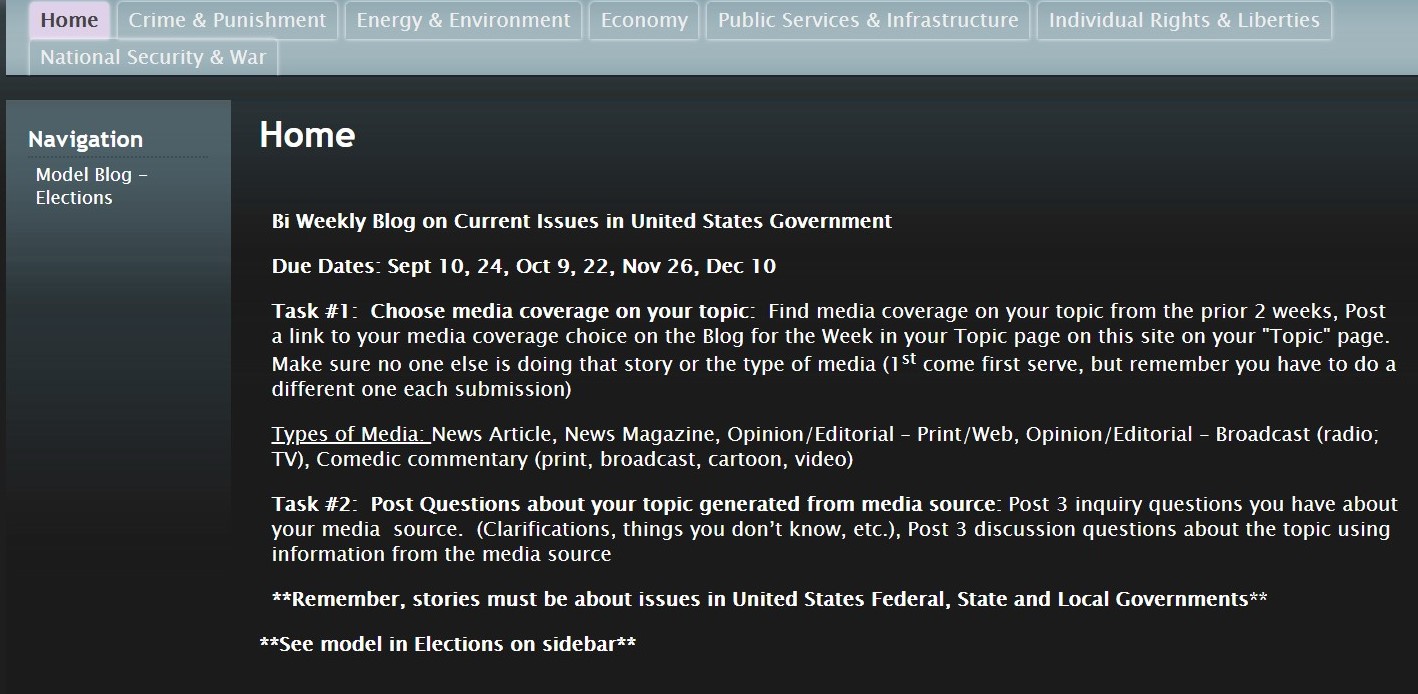
The Details:
To ensure credible sources and expand students’ skills in media analysis, each group needed to find news stories from various levels of media—local, national and international—and from different types of media—print, web and broadcast. For example, students in the Environment Issues Group posted news stories from a national print news source (The New York Times), a local news source (The Seattle Times), and a broadcast or international media source (KPTV).
To make sure the assignment was meeting the ultimate goal of students having enough background information to understand current events, students were required to create “Inquiry” or comprehension questions for the news story. As shown in the blog post below, the student asked the basic who, what and why of the article to make sure their peers understood the main point of the news story. To deepen student understanding of the event, students were also asked to create “Discussion” questions for their group which required them to use higher level questioning skills involving application and evaluation. The “Discussion” questions below ask students what they think government action should be, moving from the basics of the news story to evaluating and making a judgement based on the evidence presented.

On Current Issues day in class, we began with individual work time. Each student chose a different news story from their group to read and then posted answers to the inquiry questions in the comments section of the post. Each student verbally summarized their news story and led a discussion on the current status of the issue using the pre-prepared discussion questions. I moved from group to group to listen and join in on their discussion and marked off student participation.
The Result:
After trying out many iterations of current events in the classroom, students really took to this. Groups were always on task, both when reading the news stories and when discussing them. One year, students in the Individual Rights & Liberties group were especially engaged with news stories on the NSA and an individual’s right to privacy. During one of our Current Issues days, the group was discussing Edward Snowden and the National Security Issues group jumped in. I didn’t have to try and make the current issues have meaning or relevance to one another, it just happened naturally.
Students liked that they had class time to read current issues, access to computers to search for things they didn’t understand, and the chance to learn from the peers in their group. For a discussion on how the United States should deal with countries engaging in cyber attacks on the U.S., several students looked up the word “sanctions.” Through conversation with peers, they learned what international courts were and how they would work in this scenario. I didn’t have to fill in the background knowledge for them—my students were self-driven, finding the information themselves or working with their peers to figure it out
Throughout the semester, students developed an expertise on the topic that allowed them to have meaningful discussions in their group and share with their friends, both in and outside of the classroom. By the end of this assignment one year, the Energy & Environment group had a solid understanding of what fracking was, its advantages and disadvantages, and how public policy addressed the issue. These students ended up discussing the issue in their science and environment classes, too. They were able to bring their public policy knowledge to their science classes, and offer science insights to our class. And I ended up learning more about fracking from my students because of their engagement with the issue both inside and outside of our classroom.
I enjoyed going from group to group, listening and offering my own comments and questions to push students’ critical thinking. The informal, small groups resulted in more students participating than in a large class discussion. I knew that students were engaged and learning. Not only did the students understand current issues better as a result of this assignment, they developed invaluable skills in media analysis, researching, close reading, questioning, discussion and deliberation.
The Future:
No lesson is ever perfect. And while feedback from students was positive and learning about current events was apparent in discussion, the assignment needed modifications.
Students wanted class time to find news stories, as well as to read and discuss them. However, I still haven’t figured out how to allocate more than one day to current issues, which was already taken up by reading, posting answers to questions and discussion. Students also wanted to switch their topics for the second semester, which was an easy fix.
From the teacher perspective, the website and blog posts posed challenges with assessment:
- Grading student posts took an immense amount of time, especially because during class time I was going around from group to group listening to current events discussion.
- Not every student was talking during discussion participation check-off, so I decided to grade their discussion participation based on their written answer to their peers’ questions on the website.

Additionally, students struggled with posting reliable information and sources so I ended up requiring students only use “hard news,” not news commentary, opinion or blogs. This eliminated at least some potential for inaccurate facts. To help them with this requirement, I began the year with a unit on how to evaluate news sources for credibility and bias. This proved invaluable as “fake news” has grown over the years.



